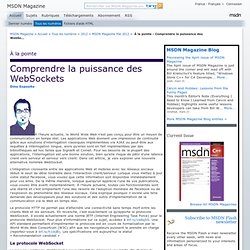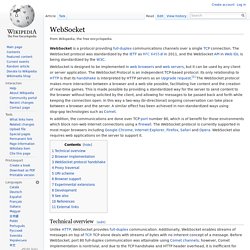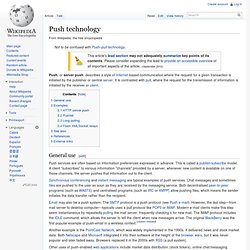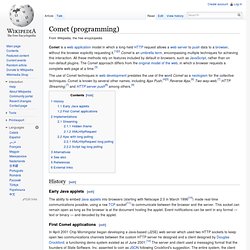

Download HAWKEN Beta Now - HAWKEN: War is A Machine. Power Soccer Review, Tips, Guide, Cheats. Power soccer (6) la power soccer (5) la power soccer (4) la power soccer (3) la power soccer (2) la power soccer (1) la Overview What’s explosive about it: Good Playerbase Smooth Gameplay Mouse Control Power Soccer is the web’s best free 3D action football game!

Featured Video.
À la pointe - Comprendre la puissance des WebSockets. À l'heure actuelle, le World Wide Web n'est pas conçu pour être un moyen de communication en temps réel.

Les applications Web donnent une impression de continuité grâce aux solutions d'interrogation classiques implémentées via AJAX ou peut-être aux requêtes à interrogation longue, alors qu'elles sont en fait implémentées par des bibliothèques ad hoc telles que SignalR et Comet. Pour les besoins de la plupart des applications, l'interrogation est une bonne solution, bien qu'elle risque de pâtir d'une latence client vers serveur et serveur vers client. Dans cet article, je vais explorer une nouvelle alternative nommée WebSocket. L'intégration croissante entre les applications Web et mobiles avec les réseaux sociaux réduit le seuil de délai tolérable dans l'interaction client/serveur. Lorsque vous mettez à jour votre statut Facebook, vous voulez que cette information soit disponible immédiatement pour vos amis. WebSocket. WebSocket is a protocol providing full-duplex communications channels over a single TCP connection.

The WebSocket protocol was standardized by the IETF as RFC 6455 in 2011, and the WebSocket API in Web IDL is being standardized by the W3C. Technical overview[edit] Browser implementation[edit] WebSocket protocol handshake[edit] To establish a WebSocket connection, the client sends a WebSocket handshake request, for which the server returns a WebSocket handshake response, as shown in the following example:[9]:section 1.2 Client request: GET /chat HTTP/1.1 Host: server.example.com Upgrade: websocket Connection: Upgrade Sec-WebSocket-Key: x3JJHMbDL1EzLkh9GBhXDw== Sec-WebSocket-Protocol: chat, superchat Sec-WebSocket-Version: 13 Origin: Push technology. General use[edit] Push services are often based on information preferences expressed in advance.

This is called a publish/subscribe model. A client "subscribes" to various information "channels" provided by a server; whenever new content is available on one of those channels, the server pushes that information out to the client. Synchronous conferencing and instant messaging are typical examples of push services. Chat messages and sometimes files are pushed to the user as soon as they are received by the messaging service.
Other uses of push-enabled web applications include market data distribution (stock tickers), online chat/messaging systems (webchat), auctions, online betting and gaming, sport results, monitoring consoles, and sensor network monitoring. Examples[edit] HTTP server push[edit] HTTP server push (also known as HTTP streaming) is a mechanism for sending unsolicited (asynchronous) data from a web server to a web browser. Pushlet[edit] Comet (programming) Comet is a web application model in which a long-held HTTP request allows a web server to push data to a browser, without the browser explicitly requesting it.[1][2] Comet is an umbrella term, encompassing multiple techniques for achieving this interaction.

All these methods rely on features included by default in browsers, such as JavaScript, rather than on non-default plugins. The Comet approach differs from the original model of the web, in which a browser requests a complete web page at a time.[3] The use of Comet techniques in web development predates the use of the word Comet as a neologism for the collective techniques.
Comet is known by several other names, including Ajax Push,[4][5] Reverse Ajax,[6] Two-way-web,[7] HTTP Streaming,[7] and HTTP server push[8] among others.[9] Even if not yet known by that name, the very first Comet implementations date back to 2000,[18] with the Pushlets, Lightstreamer, and KnowNow projects. Jeu 3D multijoueur.